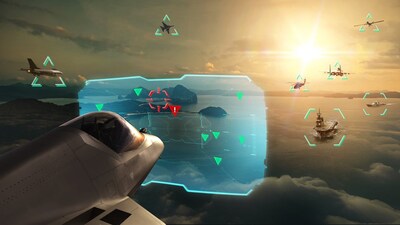Insights on the Aerospace and Defense 3D Printing Global Market to 2027 – A High Growth Rate is Expected for the Aircraft Segment
DUBLIN, Dec. 16, 2022 /PRNewswire/ — The “Aerospace and Defense 3D Printing Market – Forecasts from 2022 to 2027” report has been added to ResearchAndMarkets.com’s offering.
A 3D printer uses a software program to receive a command and create a three-dimensional object, which is called additive manufacturing.
In addition to aerospace and manufacturing, 3D printers are used in medical fields and in the medical field. As advanced technology 3D printers become available, the aerospace and defence industries’ 3D printing capabilities should improve in the coming years Aerospace companies were among the first to adopt 3D printing technology. Today, the aerospace industry continues to be considered the one that is most adept at using 3D printing technologies.
A multitude of factors contribute to this, such as faster production delivery, lower production quantities, and the ability to design for additive manufacturing. Several aerospace companies have already adopted this technology in their operations. Boeing is one such company that has been experimenting with 3D printing.
In 2019, Boeing developed the first metal 3D printed satellite antenna using 3D printing for satellite production. Located in Israel, the antenna was designed by the Israeli satellite launch company Spacecom, which successfully launched AMOS 17. In the near future, 3D printing may have an increasing impact on the aerospace industry, thereby making the market more profitable.
Commercial aircraft, military aircraft, and space technology are examples of areas where the aerospace and defense (A&D) industries have adopted additive manufacturing technology. In the aircraft 3D printing industry, in both the commercial aviation and military aviation sectors, some of the current applications include building 3D printed PMA replacement parts and designing complex aerospace parts.
The aerospace industry is a major market for the U.S. In 2019, combined sales for the aerospace and defense industry reached $909 billion, an increase of 6.7% over the previous year. The majority of this revenue, – $399 billion – was driven by shared supply chains, that support both aerospace and defense. (source: aia-aerospace.org). Based on these estimates, the aerospace industry generates significant investment and revenue, which impacts the growth of 3D printing in the field.
Growth Factors:
A high growth rate is expected for the aircraft segment
Developing and designing an aircraft involves taking into account the aircraft’s weight. Fuel consumption of lighter aircraft has decreased. There are low profits on aircraft, so aircraft that are more fuel-efficient are given preference. In technologically advanced aircraft, lightweight advanced materials – like components, parts, and airframes are used to create lightweight and advanced components without compromising strength or aerodynamics.
Several companies, including Lockheed Martin Corporation and Arconic, have recently announced joint development agreements (JDA) to develop next-generation, advanced manufacturing processes, and advanced materials. As part of their future plans, the two companies will improve current and next-generation aerospace and defense solutions by designing lightweight material systems and incorporating advanced manufacturing technologies such as metal 3D printing.
A combination of the factors described above has led to increased demand for newer generation aircraft, and may also drive the growth of the additive manufacturing industry. According to Boeing, the aircraft segment commanded the largest share of 3D printed parts during 2018.
Boeing (US) and Oerlikon (Switzerland) signed a five-year agreement in 2019 to support the development of titanium 3D printing processes. Airbus and Safran have made great progress with their Ariane6 rocket ;-using 3D printing, a single part of the injector head replaced 248 parts.
Additionally, AM technology was used to successfully print a combustion chamber that was successfully tested. Relativity Space will also work with Lockheed Martin on a 2023 NASA mission, which will involve the construction of lightweight rockets customized for the mission.
Airbus has developed a spacer panel for the A320 commercial aircraft that is 15% lighter than the original. The panel is located alongside the overhead storage compartments. A 3D-printed metal bracket from an aircraft, for example, could save 2.5 million gallons of fuel per year by reducing its weight by 50-80%. Such major developments by these companies are fuelling the growth of the market.
Restraints:
High Cost
Global aerospace and defense 3D printing market growth, however, may be hindered by high acquisition costs associated with 3D printing and a lack of raw materials.
In contrast to mills and injection mold presses, many 3D printers, including industrial printers, have relatively small build chambers. A large part would need to be sliced into sections and stitched together later, after the printer’s build chamber is full. Due to the increased printing costs and the manual labor involved, the market growth will be curtailed.
The Impact of COVID-19 on the Aerospace and Defense 3D Printing Market
As COVID-19 spread quickly, the market’s expectations were ruined. Adding to the industry’s challenges, the pandemic weakened its sales to the lowest level in a decade. Lockdowns in several countries have caused disruptions in supply chains and operational activities, worsening the market conditions.
Recent IATA estimates state that RPKs for the airline industry are expected to drop by 65.9% in 2020 as a result of the pandemic. Therefore, the market for aerospace and defense 3D printing is predicted to decline sharply in 2020, resulting in a crushing decline in sales.
Key Topics Covered:
1. INTRODUCTION
2. RESEARCH METHODOLOGY
3. EXECUTIVE SUMMARY
4. MARKET DYNAMICS
4.1. Market Drivers
4.2. Market Restraints
4.3. Porter’s Five Forces Analysis
4.3.1. Bargaining Power of Suppliers
4.3.2. Bargaining Powers of Buyers
4.3.3. Threat of Substitutes
4.3.4. Threat of New Entrants
4.3.5. Competitive Rivalry in Industry
4.4. Industry Value Chain Analysis
5. AEROSPACE AND DEFENSE 3D PRINTING MARKET, BY MATERIAL
5.1. Introduction
5.2. Metals
5.3. Polymers
5.4. Ceramics
6. AEROSPACE AND DEFENSE 3D PRINTING MARKET, BY TECHNOLOGY
6.1. Introduction
6.2. SLS
6.3. SLA
6.4. Material Jetting
6.5. Others
7. AEROSPACE AND DEFENSE 3D PRINTING MARKET, BY APPLICATION
7.1. Introduction
7.2. Prototyping
7.3. Tooling
7.4. Parts
7.5. Fixtures
7.6. Coating
8. AEROSPACE AND DEFENSE 3D PRINTING MARKET, BY GEOGRAPHY
8.1. Introduction
8.2. North America
8.2.1. United States
8.2.2. Canada
8.2.3. Mexico
8.3. South America
8.3.1. Brazil
8.3.2. Argentina
8.3.3. Others
8.4. Europe
8.4.1. Germany
8.4.2. France
8.4.3. United Kingdom
8.4.4. Spain
8.4.5. Others
8.5. Middle East and Africa
8.5.1. Saudi Arabia
8.5.2. UAE
8.5.3. Israel
8.5.4. Others
8.6. Asia Pacific
8.6.1. China
8.6.2. India
8.6.3. South Korea
8.6.4. Taiwan
8.6.5. Thailand
8.6.6. Indonesia
8.6.7. Japan
8.6.8. Others
9. COMPETITIVE ENVIRONMENT AND ANALYSIS
9.1. Major Players and Strategy Analysis
9.2. Emerging Players and Market Lucrativeness
9.3. Mergers, Acquisition, Agreements, and Collaborations
9.4. Vendor Competitiveness Matrix
10. COMPANY PROFILES
10.1. Stratasys Ltd.
10.2. 3D Systems, Inc.
10.3. Materialise
10.4. EOS Group
10.5. SLM Solutions Group AG
10.6. ENVISIONTEC, INC.
10.7. Renishaw plc
10.8. Extrude Hone (ExOne) Company
10.9. Concept Laser GmbH (GE Subsidary)
10.10. MTU Aero Engines
For more information about this report visit https://www.researchandmarkets.com/r/4rq7c3
Media Contact:
Research and Markets
Laura Wood, Senior Manager
[email protected]
For E.S.T Office Hours Call +1-917-300-0470
For U.S./CAN Toll Free Call +1-800-526-8630
For GMT Office Hours Call +353-1-416-8900
U.S. Fax: 646-607-1907
Fax (outside U.S.): +353-1-481-1716
Logo: https://mma.prnewswire.com/media/539438/Research_and_Markets_Logo.jpg
![]() View original content:https://www.prnewswire.com/news-releases/insights-on-the-aerospace-and-defense-3d-printing-global-market-to-2027—a-high-growth-rate-is-expected-for-the-aircraft-segment-301705163.html
View original content:https://www.prnewswire.com/news-releases/insights-on-the-aerospace-and-defense-3d-printing-global-market-to-2027—a-high-growth-rate-is-expected-for-the-aircraft-segment-301705163.html
SOURCE Research and Markets



 Private Internet Access gives you unparalleled access to thousands
of next-gen servers in over 83 countries and each US state. Your
VPN experience will always be fast, smooth, and reliable.
Private Internet Access gives you unparalleled access to thousands
of next-gen servers in over 83 countries and each US state. Your
VPN experience will always be fast, smooth, and reliable.

